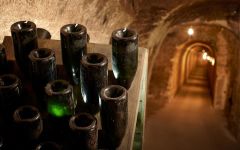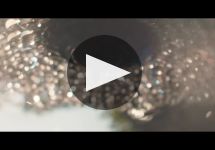Pol Roger Brut Rose 2002
-
Wine &
Spirits -
Robert
Parker -
Wine
Spectator


Product Details
Your Rating
Somm Note
Winemaker Notes
Food Pairings: Well matched by poached salmon or cold roast beef and, of course, fruit based desserts.
Professional Ratings
-
Wine & Spirits
More vintages like 2002, please...especially if they give us wines like this rosé, a quiet, persistant, thrillingly precise pinot noir-with fruit that manages to be vivid and supple, a color that hints at fresh apricot and a scent that shifts from apricot to fresh red berries. The fruit presence submerges inot the delicate fortitude of the tannin, reemerging with bass notes of wildflowers and high notes of rose. This has plenty of power in reserve if you chose to age it, adn enought substance to pour with prawns in a mildy spicy Vietnamese green curry.
-
Robert Parker's Wine Advocate
The 2002 Brut Rose Extra Cuvee de Reserve is a gorgeous wine, even if it is a bit buttoned up at this stage. Layers of well-delineated aromatics emerge over time, melding seamlessly into a chiseled, precise core of fruit. This shows quite a bit of depth and richness, all while maintaining superb freshness and clarity. Though delicious today, I imagine this will be a highly rewarding bottle to follow over the next decade or so. This is an absolutely exquisite Champagne from Pol Roger. The Rose Extra Cuvee de Reserve is 35% Chardonnay and 65% Pinot Noir, of which 15% is still Pinot, with full malolactic fermentation. Lot number illegible. Anticipated maturity: 2010-2020.
93+ points. -
Wine Spectator
A floral rosé, with a smoky undercurrent to subtle flavors of ripe plum, blackberry and black cherry. Mouthwatering acidity and fine texture steer this to the focused finish. Drink now through 2022. 300 cases imported.
Other Vintages
2018-
James
Suckling -
Robert
Parker -
Wine
Enthusiast
-
Jeb
Dunnuck -
Wine
Spectator -
Robert
Parker -
Wine
Enthusiast
-
James
Suckling -
Robert
Parker -
Wine
Spectator -
Wine
Enthusiast - Decanter
-
James
Suckling -
Robert
Parker
-
Wine
Enthusiast -
Wine
Spectator -
James
Suckling -
Robert
Parker
-
Robert
Parker -
Wine
Enthusiast -
James
Suckling -
Wine
Spectator
-
Wine
Spectator -
Tasting
Panel
-
Wine
Spectator
-
Wine
Spectator
-
Wine
Spectator







Pol Roger is one of the few remaining family-owned grande marque Champagne houses. Their grande marque status was guaranteed at the turn of the century when about 20 producers banded together to establish exacting quality controls for Champagne. The annual production at Pol Roger - less than 120,000 cases - is found in the best restaurants of France, England, and the USA, and is exported to over 30 countries. Pol Roger also was the Champagne of choice of British dignitary Sir Winston Churchill, who once said of Champagne, "...In victory I deserve it, and in defeat I need it!".

What are the different types of sparkling rosé wine?
Rosé sparkling wines like Champagne, Prosecco, Cava, and others make a fun and festive alternative to regular bubbles—but don’t snub these as not as important as their clear counterparts. Rosé Champagnes (i.e., those coming from the Champagne region of France) are made in the same basic way as regular Champagne, from the same grapes and the same region. Most other regions where sparkling wine is produced, and where red grape varieties also grow, also make a rosé version.
How is sparkling rosé wine made?
There are two main methods to make rosé sparkling wine. Typically, either white wine is blended with red wine to make a rosé base wine, or only red grapes are used but spend a short period of time on their skins (maceration) to make rosé colored juice before pressing and fermentation. In either case the base wine goes through a second fermentation (the one that makes the bubbles) through any of the various sparkling wine making methods.
What gives rosé Champagne and sparkling wine their color and bubbles?
The bubbles in sparkling wine are formed when the base wine undergoes a secondary fermentation, which traps carbon dioxide inside the bottle or fermentation vessel. During this stage, the yeast cells can absorb some of the wine’s color but for the most part, the pink hue remains.
How do you serve rosé sparkling wine?
Treat rosé sparkling wine as you would treat any Champagne, Prosecco, Cava, and other sparkling wine of comparable quality. For storing in any long-term sense, these should be kept at cellar temperature, about 55F. For serving, cool to about 40F to 50F. As for drinking, the best glasses have a stem and a flute or tulip shape to allow the bead (bubbles) and beautiful rosé hue to show.
How long do rosé Champagne and sparkling wine last?
Most rosé versions of Prosecco, Champagne, Cava or others around the “$20 and under” price point are intended for early consumption. Those made using the traditional method with extended cellar time before release (e.g., Champagne or Crémant) can typically improve with age. If you are unsure, definitely consult a wine professional for guidance.

Associated with luxury, celebration, and romance, the region, Champagne, is home to the world’s most prized sparkling wine. In order to bear the label, ‘Champagne’, a sparkling wine must originate from this northeastern region of France—called Champagne—and adhere to strict quality standards. Made up of the three towns Reims, Épernay, and Aÿ, it was here that the traditional method of sparkling wine production was both invented and perfected, birthing a winemaking technique as well as a flavor profile that is now emulated worldwide.
Well-drained, limestone and chalky soil defines much of the region, which lend a mineral component to its wines. Champagne’s cold, continental climate promotes ample acidity in its grapes but weather differences from year to year can create significant variation between vintages. While vintage Champagnes are produced in exceptional years, non-vintage cuvées are produced annually from a blend of several years in order to produce Champagnes that maintain a consistent house style.
With nearly negligible exceptions, . These can be blended together or bottled as individual varietal Champagnes, depending on the final style of wine desired. Chardonnay, the only white variety, contributes freshness, elegance, lively acidity and notes of citrus, orchard fruit and white flowers. Pinot Noir and its relative Pinot Meunier, provide the backbone to many blends, adding structure, body and supple red fruit flavors. Wines with a large proportion of Pinot Meunier will be ready to drink earlier, while Pinot Noir contributes to longevity. Whether it is white or rosé, most Champagne is made from a blend of red and white grapes—and uniquely, rosé is often produce by blending together red and white wine. A Champagne made exclusively from Chardonnay will be labeled as ‘blanc de blancs,’ while ones comprised of only red grapes are called ‘blanc de noirs.’
